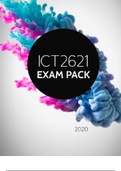Summary
Summary ICT2621 Exam Pack
- Institution
- University Of South Africa (Unisa)
Great Notes for the module with Past Exam (Q&A) and assignment. Android Boot Camp for Developers Using Javaᆴ A Guide to Creating Your First Android Apps - Hoisington, C. Edition 3rd
[Show more]



